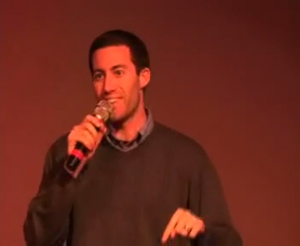Guest post by Adam Ruben, PhD. — Molecular Biologist and television host on the Discovery Channel's "Outrageous Acts of Science."
As a scientist, I often need to describe my work to others. Sometimes it’s for a media interview, sometimes it’s for a scientific conference, and sometimes it follows the question, “You spent seven years in grad school to learn to do what?”
This is where science gets tricky. In my lab, I’m the master of my domain. I know my own work, and I know how to communicate that work to another scientist. But as soon as you expose me to someone with no interest in science—what we in the biz might call a “non-sci,” or “user of Internet Explorer”—the ability to clearly describe my work disappears.
“Um,” I might stammer, “so, the reason I’m working on this is because it’s a really important way that…well, you know how, when electrons…okay, so think of an n-dimensional…actually, first you have to understand quantum theory. Do you, perchance, understand quantum theory?”
I’ve seen brilliant scientists sound anything but brilliant when asked to describe their research in a casual setting. And so, as a warning to all, I present the Top Five Epic Science Communication Fails:
5. Assuming your reader/listener/polite cousin can follow the jargon in your field. Using twenty acronyms in your first slide is bad. But assuming your audience will remember them all by Slide Two is worse. You’re far more likely to under-explain than to over-explain, so try to err on the side of hand-holding. If you’re giving a Powerpoint talk, and understanding your science relies on the relationship between four things, keep a little diagram of those four things in the corner of every slide. It’s a friendly reminder for your audience and it costs you nothing but a few pixels.
4. Assuming the purpose of your research is readily apparent. Let’s face it. Some of us can say we’re performing research with a direct, understandable purpose, like “curing AIDS” or “making cell phones unwieldy.” But for a lot of us, the truthful answer is, “We’re studying this because it fascinates us.” That’s a harder-to-understand motive than you might think—but if that’s truly your motive, own it. Don’t make up some bullcrap about relevance that you don’t even truly believe yourself.
3. Using a gigundo-normous word where a small one will do. Despite what you may conclude from reading scientific journals, the purpose of communication is not making yourself sound smart—it’s communication. Never “utilize” something you can “use.” Don’t “start up” a project you can simply “start.” Oh, you built a filtration system? No, you built a filter. Same thing, 60% fewer syllables. Believe it or not, people are likelier to think you’re smart if they can understand your good ideas than if they can’t.
2. Adding unnecessary flashiness for flashiness’s sake. “Here are our graphs” is a dry way of presenting data, but “Here are our graphs in which EACH DATA POINT IS A DIFFERENT POKEMON” is just ridiculous. Every time you plan to add fluff, ask whether that particular bell or whistle serves a useful function. “Elucidating and humanizing” is a useful function. “Brief distraction and entertainment” is actually a useful function as well. “Prolonged distraction because I just discovered that Powerpoint slides can dance” is not.
1. Losing the “story.” Our brains are wired to enjoy hearing stories. That’s why we sit at the lunch table with our coworkers, laughing about whatever wacky thing happened to one of them this morning. It’s the same with scientific presentations—the best ones aren’t just reports of results, they’re stories. They have a beginning, middle, and end. They have rising action, climax, resolution, and denouement. They have complications and problems, and sometimes they even have successes, transcendence, transformation, and heroes. When communicating your science, don’t just be a scientist. Be a storyteller.


